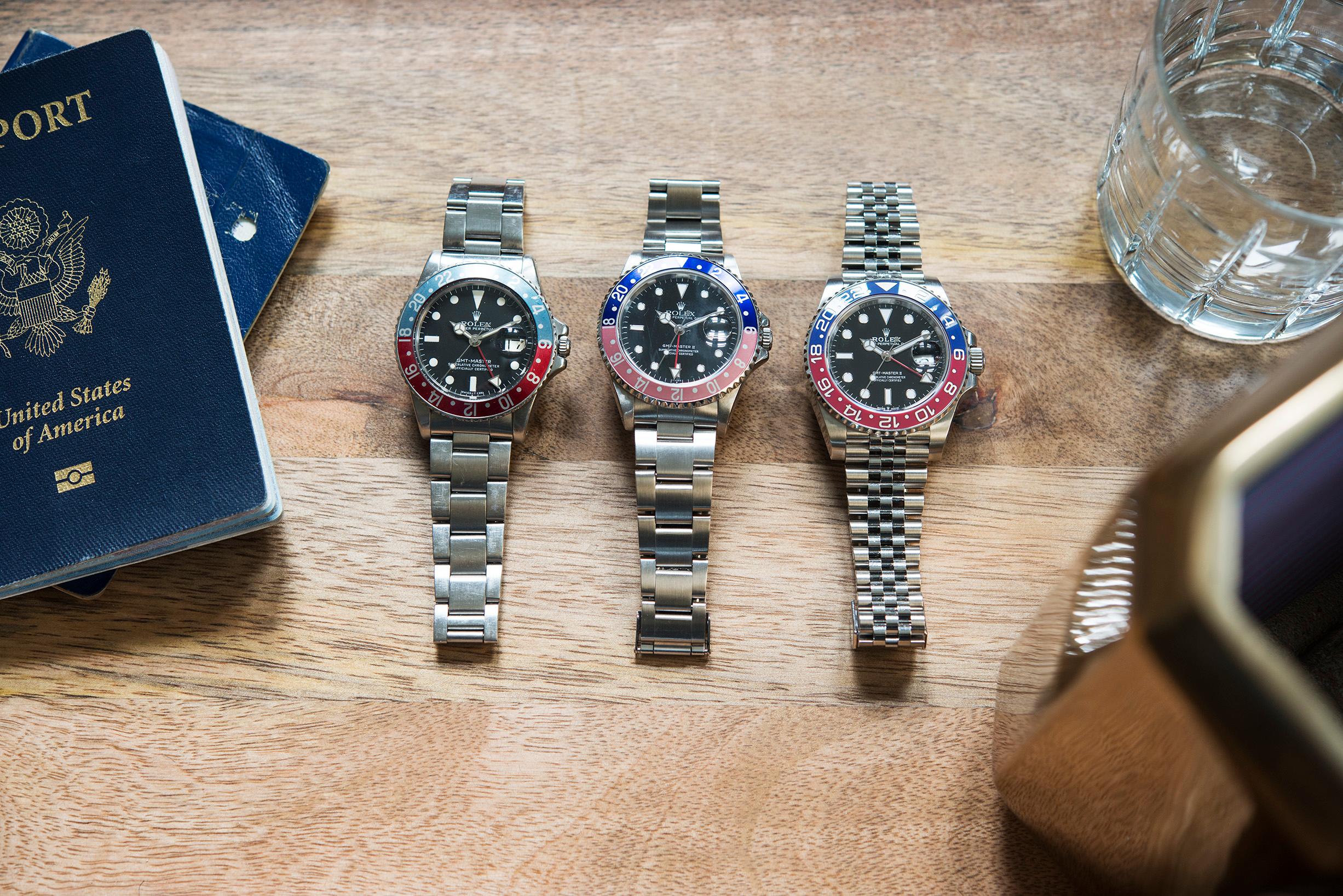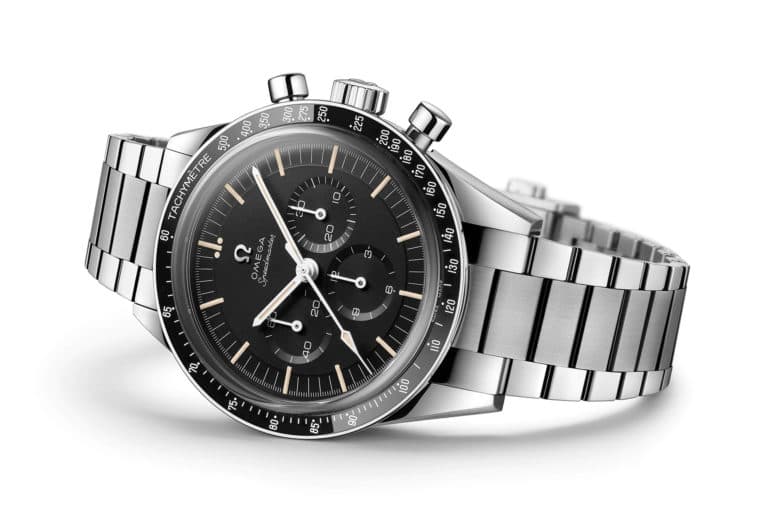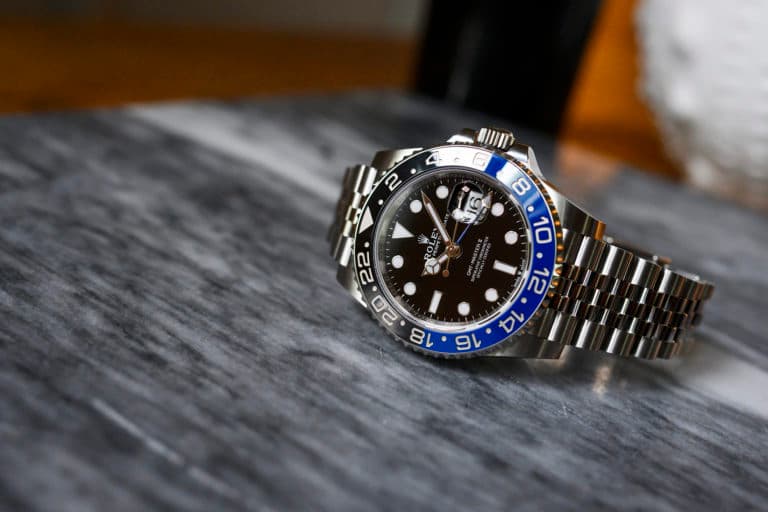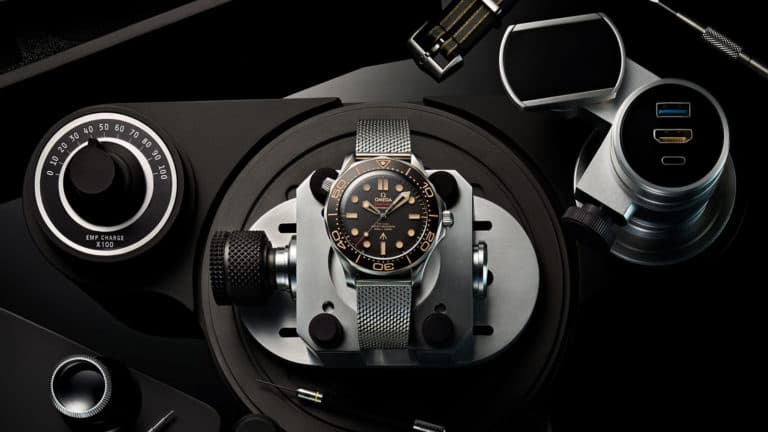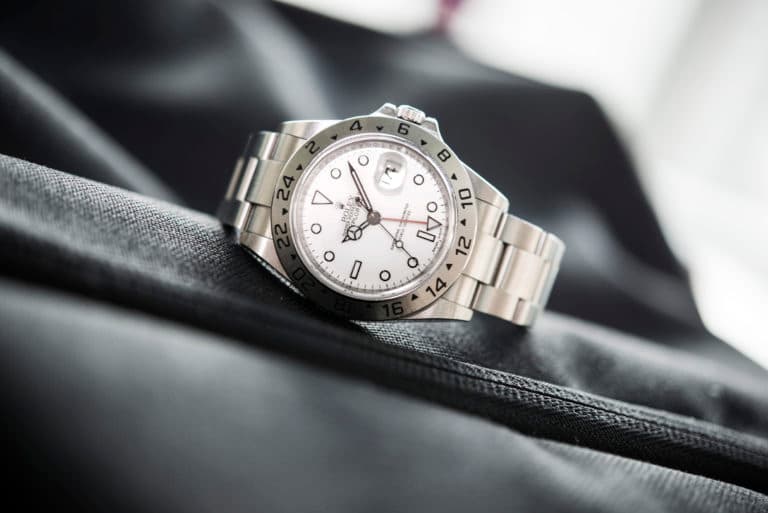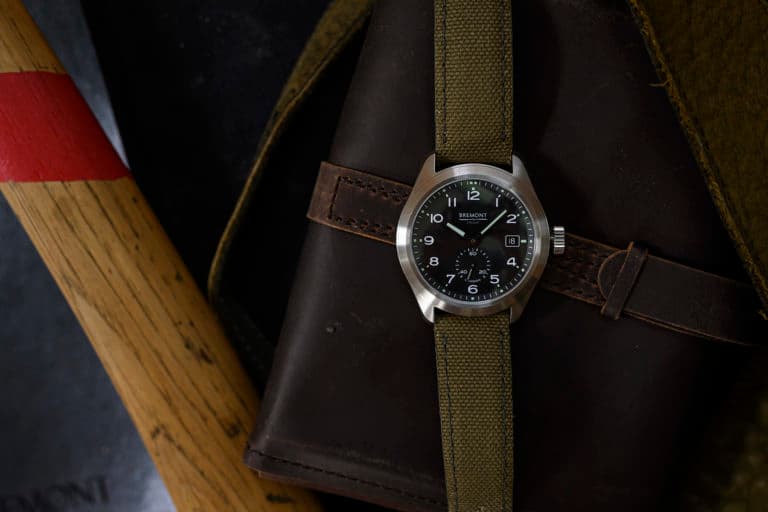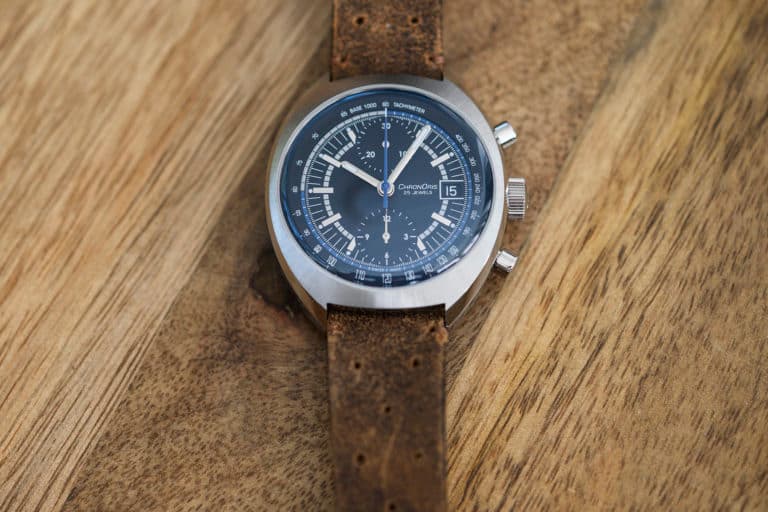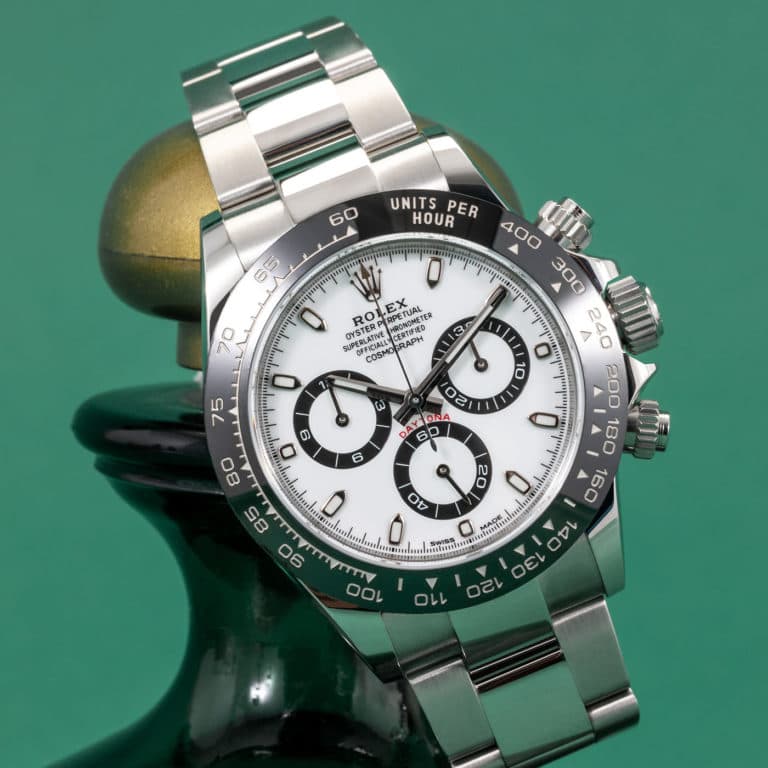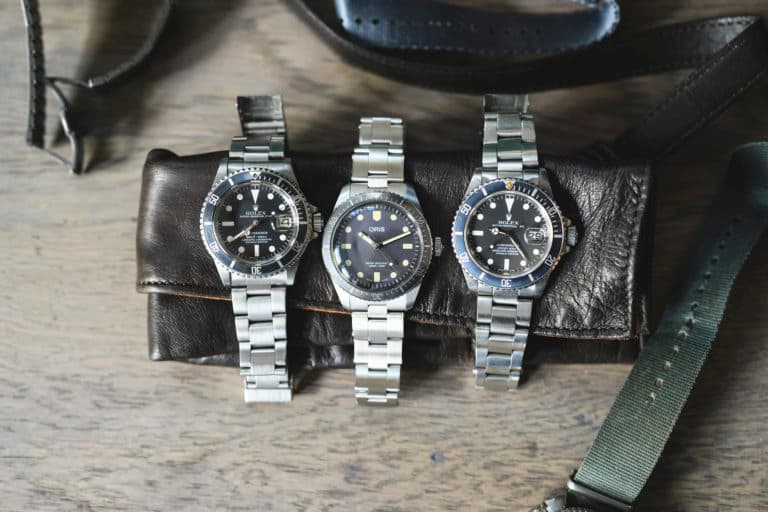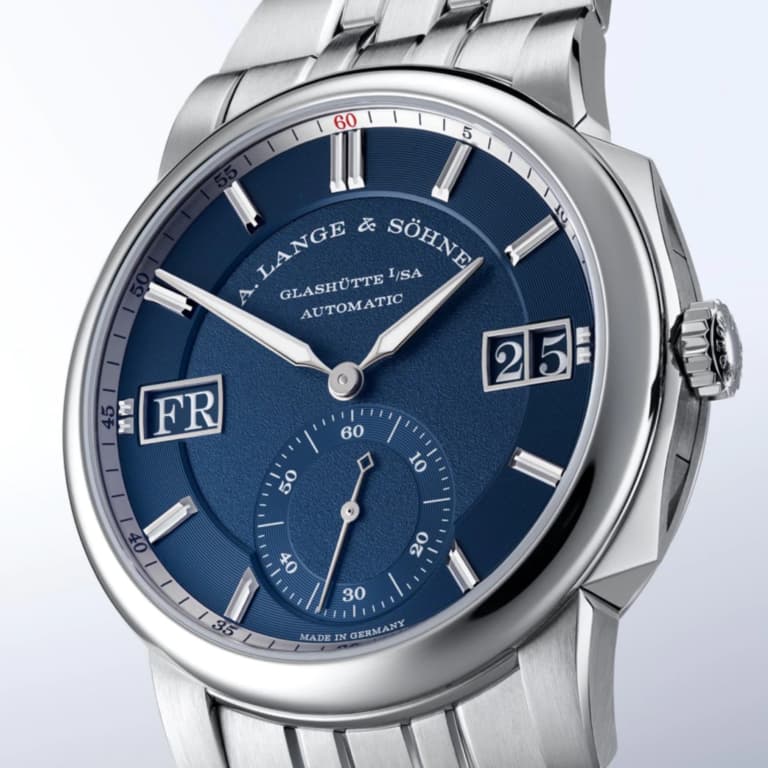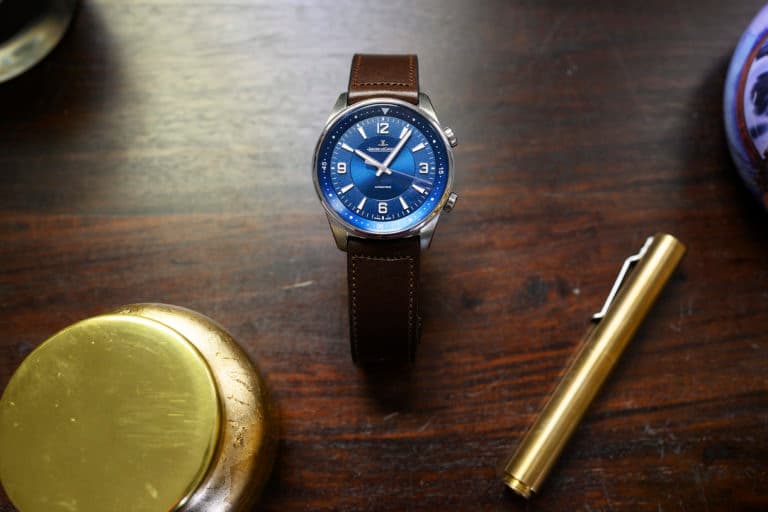Rolex surprised everyone at this year’s Baselworld with the reintroduction of a “Pepsi” bezel GMT Master II in steel, with a jubilee bracelet, no less. Predictably, wait lists at ADs around the world quickly filled, with the first few lucky owners getting their calls in recent weeks to receive their prize. With this, the hypest GMT in a generation has trickled into the open marketplace, with second-hand prices ranging from $21k to $30k. Did we mention that the retail price of this watch is $9,250? In an effort to separate the hype from the substance, we spent a week with the watch on wrist. Oh, and we brought along 2 other important references in the lineage of the “Pepsi” bezel GMT – a 1675, and a 16710 – along for historical context. How does it measure up and is it worth the premium? Let’s dive in, beginning with a bit of backstory.
The Rolex GMT Master
 Rolex began development of the GMT at the behest of PanAm airlines in the early half of the ‘50s. The dawn of the aviation age was rapidly making the world a much smaller place, and our ability to traverse time zones with ease brought a need (and desire) to simultaneously track time in two places at once. That of home, and that of the destination. Rolex was happy to oblige and developed a 24 hour hand to work alongside the regular 12-hour hand. The long red hand with small triangle tip could not be set independently, but coupled with a rotating bezel that was split into two 12 hour halves served to display Greenwich Mean Time (GMT), against which pilots could track a second-time zone. The two halves of the bezel were blue and red, and quickly took on the designation of “Pepsi” bezel thanks to similarity to the soda brands colors.
Rolex began development of the GMT at the behest of PanAm airlines in the early half of the ‘50s. The dawn of the aviation age was rapidly making the world a much smaller place, and our ability to traverse time zones with ease brought a need (and desire) to simultaneously track time in two places at once. That of home, and that of the destination. Rolex was happy to oblige and developed a 24 hour hand to work alongside the regular 12-hour hand. The long red hand with small triangle tip could not be set independently, but coupled with a rotating bezel that was split into two 12 hour halves served to display Greenwich Mean Time (GMT), against which pilots could track a second-time zone. The two halves of the bezel were blue and red, and quickly took on the designation of “Pepsi” bezel thanks to similarity to the soda brands colors.
 The first GMT wasn’t really a GMT as we know it at all, getting its start within a ref 6202 Turn-O-Graph (the watch that bore the Submariner), adding a GMT complication to the A260 caliber within. The first true GMT Master reference was the ref. 6542, which officially launched in 1954. The ref. 6542 housed the Rolex caliber 1036, which added the GMT complication to the brand’s first in-house chronometer, the 1030. The ref. 6542 used a bakelite bezel insert, blue on the top, red on the bottom, which was prone to cracking, and by 1956 was replaced by an aluminum insert of the same colors. This fact makes original ref. 6542 GMTs exceptionally rare and highly sought after by collectors. The watch found fame thanks to an appearance on the wrist of Honor Blackman (aka Pussy Galore) in the 1964 James Bond movie, Goldfinger.
The first GMT wasn’t really a GMT as we know it at all, getting its start within a ref 6202 Turn-O-Graph (the watch that bore the Submariner), adding a GMT complication to the A260 caliber within. The first true GMT Master reference was the ref. 6542, which officially launched in 1954. The ref. 6542 housed the Rolex caliber 1036, which added the GMT complication to the brand’s first in-house chronometer, the 1030. The ref. 6542 used a bakelite bezel insert, blue on the top, red on the bottom, which was prone to cracking, and by 1956 was replaced by an aluminum insert of the same colors. This fact makes original ref. 6542 GMTs exceptionally rare and highly sought after by collectors. The watch found fame thanks to an appearance on the wrist of Honor Blackman (aka Pussy Galore) in the 1964 James Bond movie, Goldfinger.
From here, the “Pepsi” bezel GMT had cemented itself as part style icon, part must-have accessory for the jet set, to what it is today, which is as much a piece of jewelry as it is a wrist-worn tool. Outside of the original ref. 6542, there are 2 other pillars of the “Pepsi” GMT in steel, those are the ref. 1675 (produced 1959 – 1980), and the ref. 16710 (produced 1989 – 2007). These two references, alongside the newest ref. 126710BLRO provide a nearly full glimpse of the GMT story since 1959 and, luckily, we’ve got all three to compare and contrast, and see just how far Rolex has come with this iconic model. Let’s briefly look at the earlier references first.
Rolex GMT Master ref. 1675
 Rolex introduced the second generation of the GMT in 1959 with the reference 1675. Updates on the original were plentiful, including crown guards, a new caliber (1565), and eventually new bezel colorways and case materials. The famous “Pepsi” blue and red bezel was joined by an all-black variant, as well as a gold/brown variant that featured a brown dial and applied hour markers. Legend has it, an all-blue (blueberry) bezel was also made in small numbers. The ref. 1675 was available on an oyster or jubilee bracelet, a first for the GMT family, and introduced a more formal look.
Rolex introduced the second generation of the GMT in 1959 with the reference 1675. Updates on the original were plentiful, including crown guards, a new caliber (1565), and eventually new bezel colorways and case materials. The famous “Pepsi” blue and red bezel was joined by an all-black variant, as well as a gold/brown variant that featured a brown dial and applied hour markers. Legend has it, an all-blue (blueberry) bezel was also made in small numbers. The ref. 1675 was available on an oyster or jubilee bracelet, a first for the GMT family, and introduced a more formal look.
 Today, the ref. 1675 is highly collectible for the manner in which it which it ages. Thanks to the use of tritium on the (once) luminous hour markers and hands, as well as specific storage conditions, these parts will age to a soft yellow or orange in varying degrees. The dials as well are prone to a lovely patina and browning over time. Each example has aged differently, and the right combinations are highly desirable by collectors assuming all original parts, and little to no signs of polishing on the case. Thanks to its size of 40mm in diameter and a touch over 12mm thick, the 1675 remains eminently wearable to this day.
Today, the ref. 1675 is highly collectible for the manner in which it which it ages. Thanks to the use of tritium on the (once) luminous hour markers and hands, as well as specific storage conditions, these parts will age to a soft yellow or orange in varying degrees. The dials as well are prone to a lovely patina and browning over time. Each example has aged differently, and the right combinations are highly desirable by collectors assuming all original parts, and little to no signs of polishing on the case. Thanks to its size of 40mm in diameter and a touch over 12mm thick, the 1675 remains eminently wearable to this day.
Rolex GMT Master II ref. 16710
 In 1983 Rolex introduced the first GMT Master II in the reference 16760 (the Fat Lady), which used an entirely new caliber, the 3085. By 1989, Rolex had moved on to the 16710 and the updated caliber 3185 which, along with a few other updates, would take the watch into a new generation. The dial takes a big step in a new direction with the introduction of white gold surrounds on the hour markers, a feature that remains in place to this day. The small change makes a substantial change in the personality of the watch at a glance and serves as an informal dividing line between vintage and contemporary Rolex.
In 1983 Rolex introduced the first GMT Master II in the reference 16760 (the Fat Lady), which used an entirely new caliber, the 3085. By 1989, Rolex had moved on to the 16710 and the updated caliber 3185 which, along with a few other updates, would take the watch into a new generation. The dial takes a big step in a new direction with the introduction of white gold surrounds on the hour markers, a feature that remains in place to this day. The small change makes a substantial change in the personality of the watch at a glance and serves as an informal dividing line between vintage and contemporary Rolex.
The GMT ref. 16710 has increasingly been on the radar of collectors and has seen its second-hand prices go from the $6-7k range to the $9-10k range in recent years. The aluminum bezels from early examples are known to fade in unique, and sometimes beautiful ways. Given this reference’s long production span, it welcomed a range of updates throughout its tenure. Most notably, we got a new colorway for the bezel consisting of black and red that quickly gained the “Coke” moniker, naturally. The dial used tritium until 1997 before transitioning to luminova, and eventually superluminova until the end of its production run in 1997. Near the end of its run, the ref. 16710 received an upgrade from its caliber 3185 with the 3186, which featured hacking and a quickset 24 hour hand.
 On the wrist, the ref. 16710 is easy to get along with at a shade under 40mm in diameter and around 12mm in case thickness. The oyster bracelet transitioned from hollow to solid end links around 2000 and provides a more confident fit. Overall this is a watch that bridges the past to the present, retaining much of the charm of the older models on the wrist, while embracing some amenities we take for granted these days (changing the date more than a few days on a 1675 will quickly remind one of how good we have it these days).
On the wrist, the ref. 16710 is easy to get along with at a shade under 40mm in diameter and around 12mm in case thickness. The oyster bracelet transitioned from hollow to solid end links around 2000 and provides a more confident fit. Overall this is a watch that bridges the past to the present, retaining much of the charm of the older models on the wrist, while embracing some amenities we take for granted these days (changing the date more than a few days on a 1675 will quickly remind one of how good we have it these days).
A New Generation of “Pepsi”
In 2007, Rolex introduced a new generation of the GMT-Master II family, the ref. 116710. The new watch brought a distinct departure from previous references thanks to a new, more robust case design, a redesigned dial, and a ceramic bezel. New colorways were also introduced within steel and gold metals, most notably the BLNR (BLueNoiR) in 2013, which took the nickname “Batman” due to the colors’ resemblance to early suit designs of the caped crusader. Suspiciously absent from this generation of GMT was a “Pepsi” bezel in steel. For that, you’d have to jump to a white gold GMT, the ref. 116719 BLRO which Rolex brought to the 2014 Baselworld fair. The popular colorway was welcomed back, but the $35,000 price tag put it well outside the reach of most collectors.
Approaching the 2018 edition of Baselworld, Rolex began teasing a new watch, and the rumor mill went into full swing. Would they bring back the “Coke” bezel? An entirely new colorway? One possibility that seemed remote, was bringing the famous “Pepsi” bezel back into the steel given its relegation to precious metal territory. Surely, bringing it back to a steel case would tarnish the lavish reputation it had gained in recent years. But, then it happened. Rolex dropped the 126710BLRO (BLueROuge aka “Pepsi”) on a jubilee bracelet, in steel. The white gold model remains, but went to a dark blue dial to differentiate it from the steel models. The collective watch world picked up their phone, scrambling to get on their nearest AD’s list for a chance to purchase. Given their habit of restricting production of steel sports models in recent years, securing a new model is no easy feat. As the first examples hit the market, prices have immediately doubled the $9,250 retail price. A trend we don’t see dying anytime soon. Is it worth the hype? Has it lost its identity so carefully established from generations past? We spent a week with one to find out.
Rolex GMT-Master II 126710BLRO
 Let’s get this out of the way right off the bat, the new steel GMT “Pepsi” is a thoroughly modern watch, and if you’re hoping for any semblance of throwback charm, you won’t find it here. It’s best to judge the new watch on its own merit, removed from any standards set by older references. If you prefer the older watches in look and wrist feel, you likely won’t find much to love about the newest models. That’s not to say they aren’t incredibly engineered and beautiful watches in their own right, but they have drifted into “jewelry” territory in a few ways their predecessors couldn’t have dreamed.
Let’s get this out of the way right off the bat, the new steel GMT “Pepsi” is a thoroughly modern watch, and if you’re hoping for any semblance of throwback charm, you won’t find it here. It’s best to judge the new watch on its own merit, removed from any standards set by older references. If you prefer the older watches in look and wrist feel, you likely won’t find much to love about the newest models. That’s not to say they aren’t incredibly engineered and beautiful watches in their own right, but they have drifted into “jewelry” territory in a few ways their predecessors couldn’t have dreamed.
The 126710BLRO is a beautiful watch. Taken on its own, the steel BLRO has a wealth of detail to appreciate, from the clasp and bracelet to the bezel and dial. The jubilee bracelet may seem an odd choice, but there’s a precedent there. The jubilee bracelet made its first appearance on the GMT with the ref. 1675, and has been an available option for the watch up until 2007. While you’d typically see them on precious metal and two-toned cases, they’ve had a long-standing relationship with the GMT family. Somewhat ironically, the white gold GMT with “Pepsi” bezel is available exclusively on an oyster bracelet, so in order to keep some distance between the two, the steel is only available on the jubilee. In fact, the steel BLRO uses a different lug and pin configuration to make swapping a more difficult (but still possible) proposition.
 The jubilee bracelet is a superb bit of engineering. The fit and finish are second to none and simply melts over the wrist. Rolex have been doing jubilee bracelets since 1945, and it’s clear all that know-how made its way into this execution. The Oysterlock clasp is a marked improvement over the clap designs of past references, which typically feature a single piece of stamped steel that hinges. The new design feels incredibly well engineered and operates with ease. It’s easily one of the strongest components of the watch as a whole.
The jubilee bracelet is a superb bit of engineering. The fit and finish are second to none and simply melts over the wrist. Rolex have been doing jubilee bracelets since 1945, and it’s clear all that know-how made its way into this execution. The Oysterlock clasp is a marked improvement over the clap designs of past references, which typically feature a single piece of stamped steel that hinges. The new design feels incredibly well engineered and operates with ease. It’s easily one of the strongest components of the watch as a whole.
 As good as the bracelet is, it’s also one of the most divisive. The jubilee design is beautiful in the hand, it’s very well made, it’s comfortable, and it’s quite… ornate. That becomes an issue for those who see the GMT as a historic tool watch. It’s difficult to put this watch on the wrist and not feel underdressed. Especially if you’re a person who gets away with t-shirts and jeans most of the time. The polished center links don’t really help the situation here, either. It looks and feels more like a piece of jewelry than any prior reference in steel, and longtime GMT owners will find this problematic. The ultimate charm of a ref. 1675 and even the ref. 16710 is precisely how unpretentious they are, how easily they can be paired with both the informal and formal ends of your wardrobe, all of which speaks volumes to the GMT’s nature as a true tool.
As good as the bracelet is, it’s also one of the most divisive. The jubilee design is beautiful in the hand, it’s very well made, it’s comfortable, and it’s quite… ornate. That becomes an issue for those who see the GMT as a historic tool watch. It’s difficult to put this watch on the wrist and not feel underdressed. Especially if you’re a person who gets away with t-shirts and jeans most of the time. The polished center links don’t really help the situation here, either. It looks and feels more like a piece of jewelry than any prior reference in steel, and longtime GMT owners will find this problematic. The ultimate charm of a ref. 1675 and even the ref. 16710 is precisely how unpretentious they are, how easily they can be paired with both the informal and formal ends of your wardrobe, all of which speaks volumes to the GMT’s nature as a true tool.
The cases of 6-digit reference GMTs are more substantial than earlier examples, featuring thicker lugs and case walls. It’s a heft you notice on the wrist, but it falls short of distracting in the manner many other large watches suffer from. It’s a trend Rolex has stuck with for their sport models, but it’s worth noting that this year, at the very same Baselworld they introduced the steel BLRO, they also introduced a slight revision to the Sea-Dweller, which toned down the lugs to a degree. It remains to be seen if they’ll continue to dial the heft back down in the years to come, but this could be a slight tip of the hand.
 Now, let’s talk about that bezel. Rolex has received criticism for their take on the “Pepsi” colorway in ceramic (Rolex calls it Cerachrom), in large part due to the bottom, or ROuge half. Older bezel inserts have a very crisp contrast between the blue and the red, with the red being vibrant and crisp. In ceramic, the red leans into fuchsia territory, taking on notes of purple and pink. Pictures exaggerate this imbalance, as I didn’t find it distracting in the least during daily wear. It catches light beautifully, and at a glance holds the spirit of older examples. The Cerachrom is certainly unique, appearing glossy and almost milky in some light, and my only real issue with it is that, unlike previous references, it will almost surely stay exactly the same over its lifespan. The “Pepsi” bezel GMT is famous for its character with age, as no two examples seem to take on aging quite the same. Some fade a lot, some a little, some take on seemingly new hues in surprising and unpredictable ways. I’d argue this fact has given the GMT the reputation it so enjoys today. What will the Cerachrom “Pepsi” bezel look like in 40 years? Likely the same as it does today. Can we really criticize a product for lasting longer, though?
Now, let’s talk about that bezel. Rolex has received criticism for their take on the “Pepsi” colorway in ceramic (Rolex calls it Cerachrom), in large part due to the bottom, or ROuge half. Older bezel inserts have a very crisp contrast between the blue and the red, with the red being vibrant and crisp. In ceramic, the red leans into fuchsia territory, taking on notes of purple and pink. Pictures exaggerate this imbalance, as I didn’t find it distracting in the least during daily wear. It catches light beautifully, and at a glance holds the spirit of older examples. The Cerachrom is certainly unique, appearing glossy and almost milky in some light, and my only real issue with it is that, unlike previous references, it will almost surely stay exactly the same over its lifespan. The “Pepsi” bezel GMT is famous for its character with age, as no two examples seem to take on aging quite the same. Some fade a lot, some a little, some take on seemingly new hues in surprising and unpredictable ways. I’d argue this fact has given the GMT the reputation it so enjoys today. What will the Cerachrom “Pepsi” bezel look like in 40 years? Likely the same as it does today. Can we really criticize a product for lasting longer, though?
One of the biggest updates to the newest steel BLRO is one you can’t see, the entirely new Rolex developed and built caliber 3285. Like all Rolex movements, it’s a certified chronometer (superlative, even), meaning it won’t lose more than 4 seconds or gain more than 6 seconds on a daily average. In my time with the watch, it never fell outside a 1-second deviation. We can thank the addition of the Rolex’s Chronergy escapement for much of this, as it boosts efficiency by 15% over the outgoing escapement (not sure what an escapement is? read this). They’ve accomplished this by reconsidering each component in the power delivery and regulation systems, going so far as to skeletonize the escape wheel. The Chronergy escapement was introduced in the caliber 3255 at use within the Day-Date, and its clever take on the Swiss lever escapement is now making its way into more calibers, no surprise there. What makes it so clever? The new system strips many of the inefficiencies that plague traditional lever escapements, by providing direct impulse of the balance by the escape wheel, and relying on the lever system as a sort of safety net, meaning less overall friction and more stability and efficiency in how the power is being managed and doled out. Rolex’s Parachrom hairspring takes center stage within. It all adds up to remarkable accuracy in practice, and a guaranteed power reserve of 70 hours. Not a bad shake.
 What’s all this like on the wrist? Wearing the 126710BLRO is easy, comfortable and practical. It doesn’t feel nostalgic, it feels like Rolex pinning their ears back and only moving in one direction to the future. This is a better watch in every single way than previous generations of the GMT, and it makes no apologies in being so. The color of the bezel is a mere afterthought compared to the accomplishment of the rest of the watch. In this sense, it’s nearly impossible to judge it against its predecessors, as it demands to be taken for what it is, on its own right. While it’s hard to find fault in the watch, it certainly leaves behind a lot of the charm of past references. However, when Rolex set out to make the ref. 1675 and the ref. 16710, I doubt they were too concerned with such “charm” – and were they capable, I’m guessing they would have made exactly what we see in the ref. 126710BLRO.
What’s all this like on the wrist? Wearing the 126710BLRO is easy, comfortable and practical. It doesn’t feel nostalgic, it feels like Rolex pinning their ears back and only moving in one direction to the future. This is a better watch in every single way than previous generations of the GMT, and it makes no apologies in being so. The color of the bezel is a mere afterthought compared to the accomplishment of the rest of the watch. In this sense, it’s nearly impossible to judge it against its predecessors, as it demands to be taken for what it is, on its own right. While it’s hard to find fault in the watch, it certainly leaves behind a lot of the charm of past references. However, when Rolex set out to make the ref. 1675 and the ref. 16710, I doubt they were too concerned with such “charm” – and were they capable, I’m guessing they would have made exactly what we see in the ref. 126710BLRO.
Who’s It For, Who’s It Not For
 The new BLRO will be many different things to many different people, all of whom have their own expectations and history with the GMT family. This is not going to be a watch for the vintage collector and traditionalist; if you don’t think Rolex has made a proper watch since 1985, this isn’t going to change your mind, trust me. If, on the other hand, you’re tempted by some of the newer hardware coming out of the Crown in recent years, this will be the culmination of that movement. This is a watch for new school Rolex buyers, who want the very best, and don’t mind a little flash built in. They understand the role of the mechanical wristwatch in the year 2018 and realize we aren’t as reliant on their tool status as we used to be. If you own a gold Day-Date and want something you can dress down, though, maybe look at a Sub instead of this guy.
The new BLRO will be many different things to many different people, all of whom have their own expectations and history with the GMT family. This is not going to be a watch for the vintage collector and traditionalist; if you don’t think Rolex has made a proper watch since 1985, this isn’t going to change your mind, trust me. If, on the other hand, you’re tempted by some of the newer hardware coming out of the Crown in recent years, this will be the culmination of that movement. This is a watch for new school Rolex buyers, who want the very best, and don’t mind a little flash built in. They understand the role of the mechanical wristwatch in the year 2018 and realize we aren’t as reliant on their tool status as we used to be. If you own a gold Day-Date and want something you can dress down, though, maybe look at a Sub instead of this guy.
The Rolex GMT-Master II 126710BLRO is available from authorized retailers right now (don’t expect to see them on shelves anytime soon, though) for the price of $9,250. Find this watch on StockX right here, and explore the entire GMT-Master II family right here.


